A Guide to Project Management Process Groups
Every successful project needs a detailed execution framework that fits into phases called project management process groups.
These groups are part of the Project Management Institute’s massive set of standard terminology and guidelines for project management, the Project Management Body Of Knowledge (aka PMBOK).
In this article, we’ll cover everything you need to know about the five project management process groups, their importance, and their purpose in the end-to-end project delivery machine.
Key Takeaways:
- Project management process groups include initiation, planning, execution, monitoring and control, and closure.
- Initiation involves defining project objectives, identifying stakeholders, and authorizing the project.
- Planning encompasses project scope, schedule, cost, quality, and risk management activities.
- The execution process coordinates project resources and manages stakeholder expectations to deliver the project scope.
- Monitoring and control track project performance metrics, perform quality control, analyze variances, and recommend corrective actions.
What Are Project Management Process Groups?
The project management process groups are a structured framework of project management processes. This framework is basically a project management plan. It guides projects throughout the project lifecycle — from initiation to project closing, and is especially useful when applying process groups to digital project environments.
Each group has specific goals and objectives. There are five project management process groups:
- Initiating – here, you formally get authorization and kick off the project.
- Planning – here, you develop execution plans that cover scope, schedule, budget, quality, and project risk management procedures.
- Executing – here, you coordinate with your team to execute your plans.
- Monitoring and Controlling – here, you monitor progress and, if needed, make adjustments.
- Closing – here, you wrap up the project with completed project deliverables.
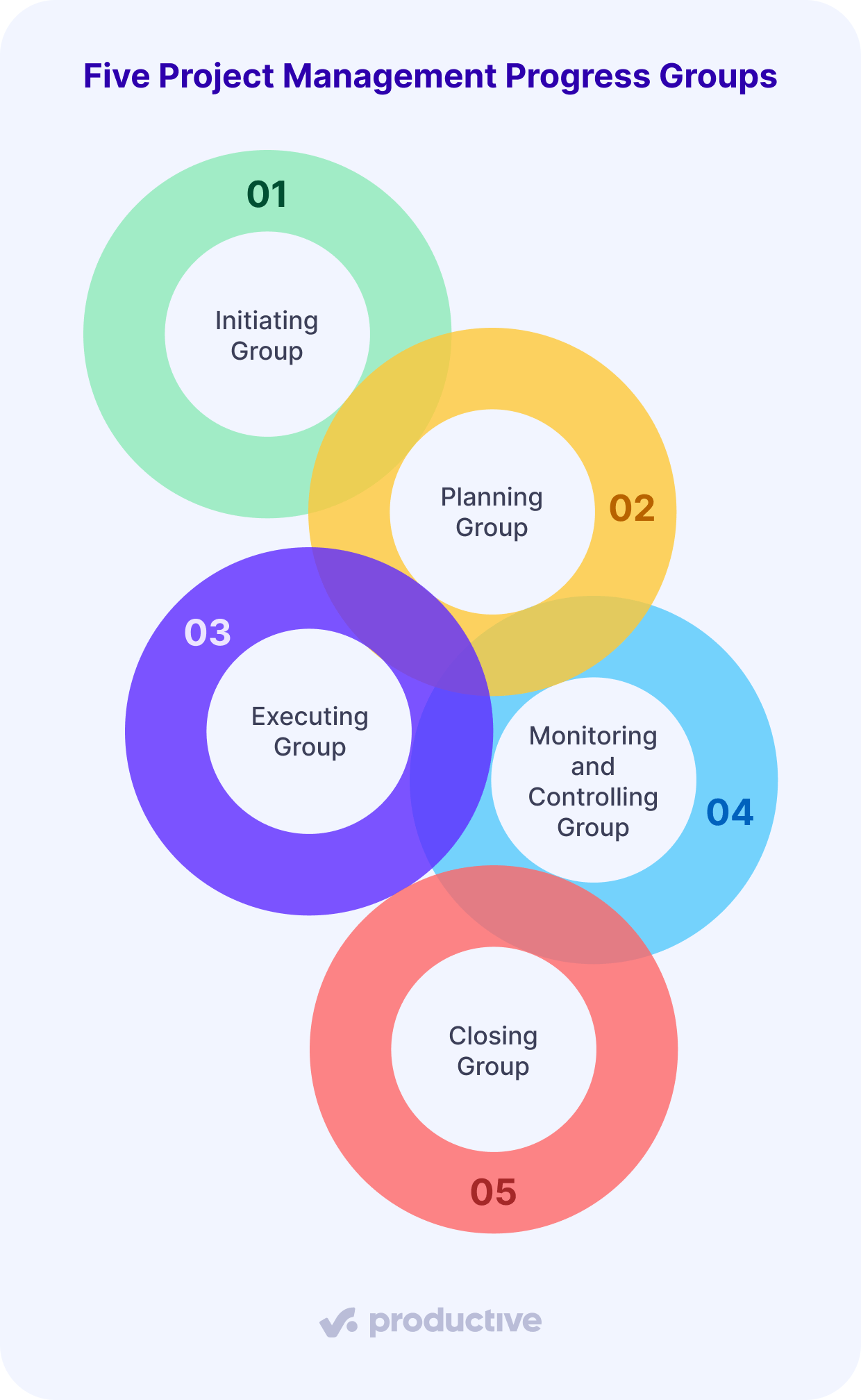
In the following sections, we’ll dissect each group, and talk about its purpose and project activities.
Group 1: Initiating
The initiating process group is the official start of the project.
In this initiating phase you’ll align stakeholders’ (or project sponsors) expectations with the project’s purpose, provide visibility about the scope and objectives. It’s also super important that you explain to the project stakeholders how their engagement contributes to achieving desired outcomes.
Next, you need to create a project charter to formally authorize the project, and grant the project manager authority to allocate resources.
The project charter is the main output of the initiating process group. Identify and analyze stakeholders to understand their interests, influence, and potential impact on the project. Include your findings in the stakeholder register.
Perform feasibility assessments using project selection methods, and define the project scope at a high level. Identify risks, assumptions, and constraints that may affect the project.
The key deliverables of the initiation phase are the project charter, stakeholder register, business case, and a high-level timeline and cost estimate.
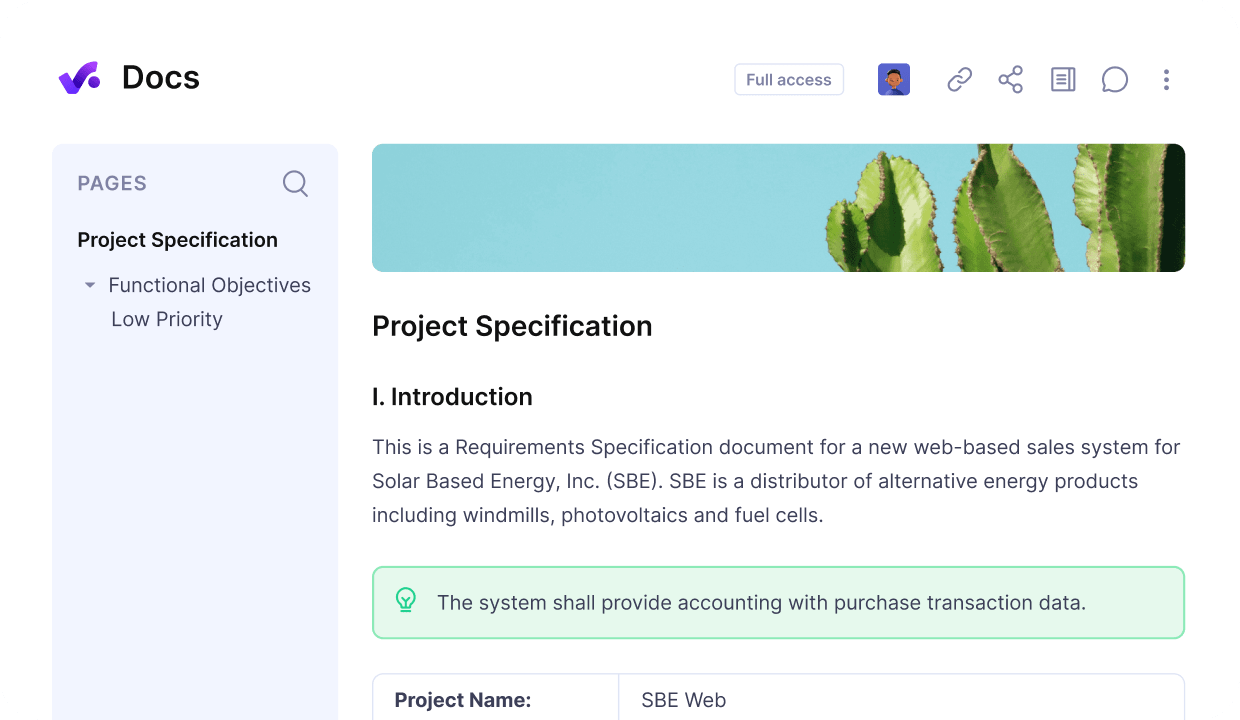
Organize, document, and track your project REGISTERS AND DOCUMENTATION in one place with Productive’s intuitive documentation tools.
Group 2: Planning
Now comes the planning stage. Once you’ve initiated the project, you need to develop a comprehensive plan outlining how you’ll achieve the project’s objectives.
The planning process group consists of:
- Project scope management
- Scheduling
- Cost management
- Quality and resource management
In the project scope, you’ll plan ahead how to manage scope, collect requirements, create a Work Breakdown Structure (WBS), and validate the scope.
Scheduling involves establishing project schedule management, defining and sequencing activities, estimating activity durations, and developing the schedule.
For project cost management, you’ll need to estimate costs, determine the project budget, figure out how to implement cost control, and establish a cost baseline.
Quality and resource planning include activities like planning quality management, resource management, estimating activity resources, developing communication channels, and risk management.
The goal of the project planning phase is to identify potential risks and develop mitigation and risk response strategies. All those processes are interconnected and are the foundation of a thorough project plan.
Group 3: Executing
You’re now ready to move forward into the executing process group. The project processes of this phase focus on coordinating resources and managing stakeholder expectations.
While the execution phase is happening, you need to lead your project team and keep them focused on delivering the project objectives according to the plan.
Communicate regularly with the stakeholders to maintain engagement and ongoing support. Keep the stakeholders in the loop so that they’re involved and supportive throughout the project lifecycle.
Key project management activities of the execution phase are implementing procurement, executing processes and tasks, and implementing quality and risk management plans. You also need to manage approved changes.
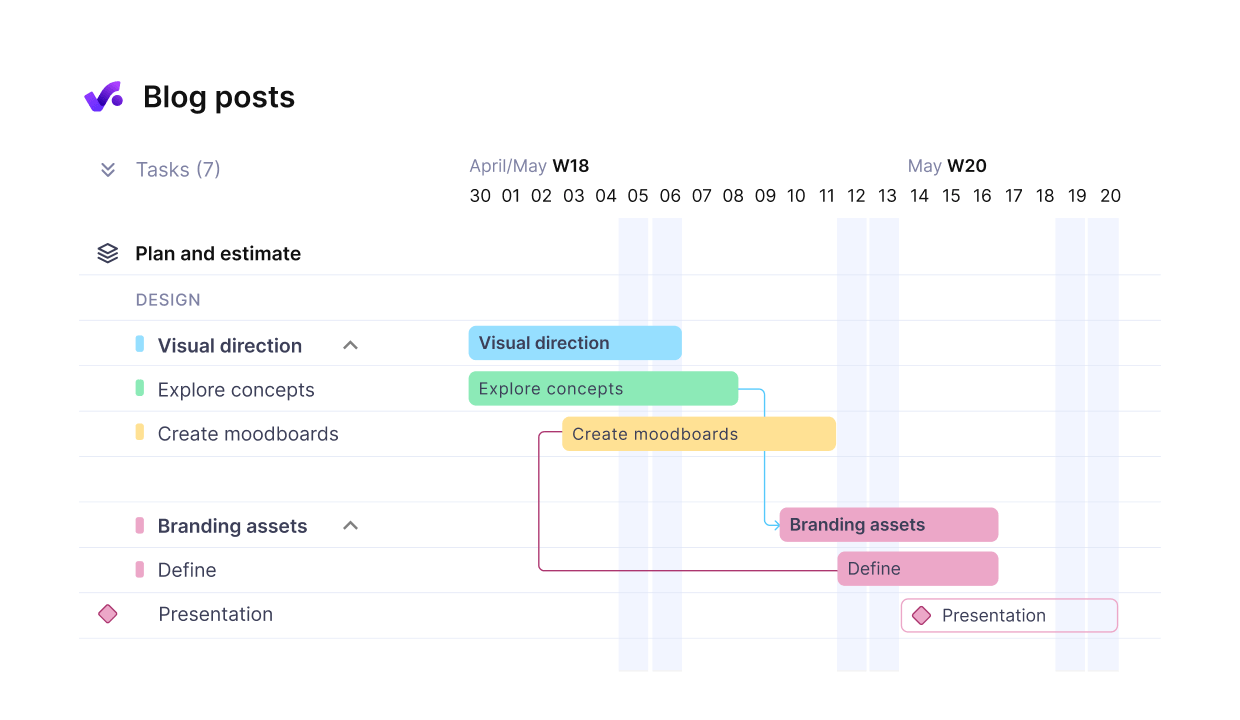
Keep your projects on track with clear task dependencies and seamless collaboration. Productive makes managing project progress easy.
Group 4: Monitoring and Controlling
The monitoring and controlling process group is all about keeping an eye on project progress and performance. With active project monitoring, you’ll track deliverables, control changes, and guarantee that quality standards are met.
This controlling phase consists of:
- Monitoring work performance and comparing actual results against the project management plan
- Analyzing variances and evaluating trends to identify necessary process improvements
- Recommending preventive and corrective actions to address issues and risks
- Validating project scope to formalize acceptance of completed project deliverables
During this phase, we recommend that you leverage project management tools like earned value management (EVM), track performance metrics, perform regular risk audits, issue logs.
All of the mentioned tools and activities will help you maintain a firm grasp on the project’s trajectory.
Remind your to team maintain regular performance reports and updates to the project knowledge repository. Clean logs and up-to-date reports keep stakeholders informed and prepared for the next steps.
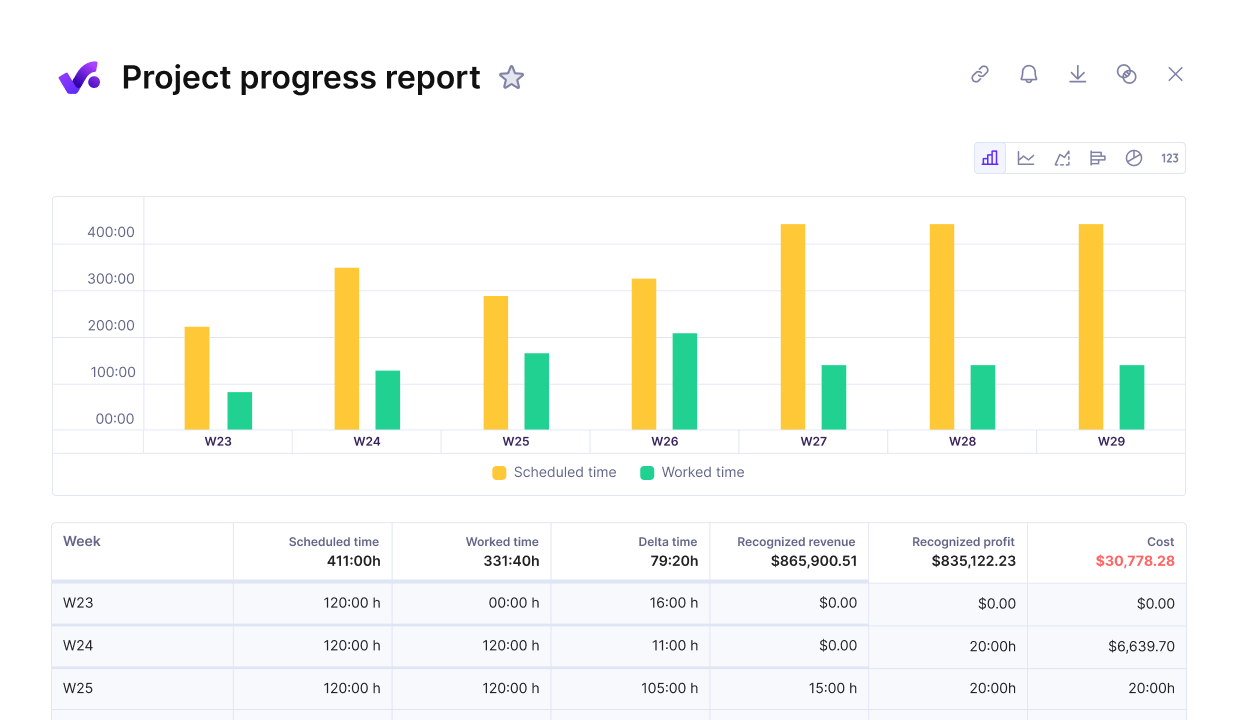
Track time, measure progress, and optimize efficiency with Productive—your all-in-one project management solution.
Group 5: Closing
In the closing process group, you’ll tie up all the loose ends and officially conclude the entire project. Here, you’ll complete contract closures, verify product scope requirements, and get formal acceptance from key stakeholders.
Document the lessons learned. Learning from your experience will help future project managers avoid potential pitfalls. You’ll also need to submit final performance reports and collect and archive project documents for future reference.
The closing process group consists of two main processes:
- Close Procurement: The formal closure of procurement contracts
- Close Project or Phase: Officially finalize the project or phase, ensuring all activities are completed.
Project Processes and Knowledge Areas
Each stage has its process. Those processes connect to a specific knowledge area to ensure that work is structured, efficient, and aligned with project goals.
Here’s a breakdown of the processes, their purposes and knowledge area of impact:
Process: Directing and Managing Project Work
- Knowledge Area: Project Integration Management
- Purpose: Achieve project objectives using existing knowledge.
Process: Manage Project Knowledge
- Knowledge Area: Project Integration Management
- Purpose: Use and create knowledge to meet project goals.
Process: Acquiring Resources
- Knowledge Area: Project Resource Management
- Purpose: Obtain necessary resources to keep projects on track.
Process: Developing a Team
- Knowledge Area: Project Resource Management
- Purpose: Improve team abilities, skillsets and interactions for better collaboration.
Process: Quality Management
- Knowledge Area: Project Quality Management
- Purpose: Ensure the quality management plan is executed effectively.
Process Group Interdependence
The project management chain starts with the initiating phase and ends and successful outcomes.
While each process group plays a distinct role in project management, they don’t operate in isolation. Great and consistent execution of every group sets the stage for the next one. This interdependence between these groups directly translates to effectiveness of project execution.
Initiation phase and project planning phase are tightly linked, as the project scope and goals defined in initiation directly influence the detailed plans developed in the planning phase.
Execution heavily relies on the plans and schedules from the planning group while monitoring, controlling, and continuously evaluating the progress and performance of the executed tasks.
The monitoring and controlling group interacts with all other process groups, ensuring project goals are met by adjusting plans and execution as necessary. In today’s workplace, this also means initiating and managing hybrid teams effectively so collaboration remains seamless across remote and in-office contributors.
Managing these interdependencies involves identifying potential dependencies, evaluating their impact, negotiating agreements, integrating them into project plans, and continuously monitoring their status.
The closing process group marks the formal end of the project or phase. All activities are completed and the project is properly concluded.
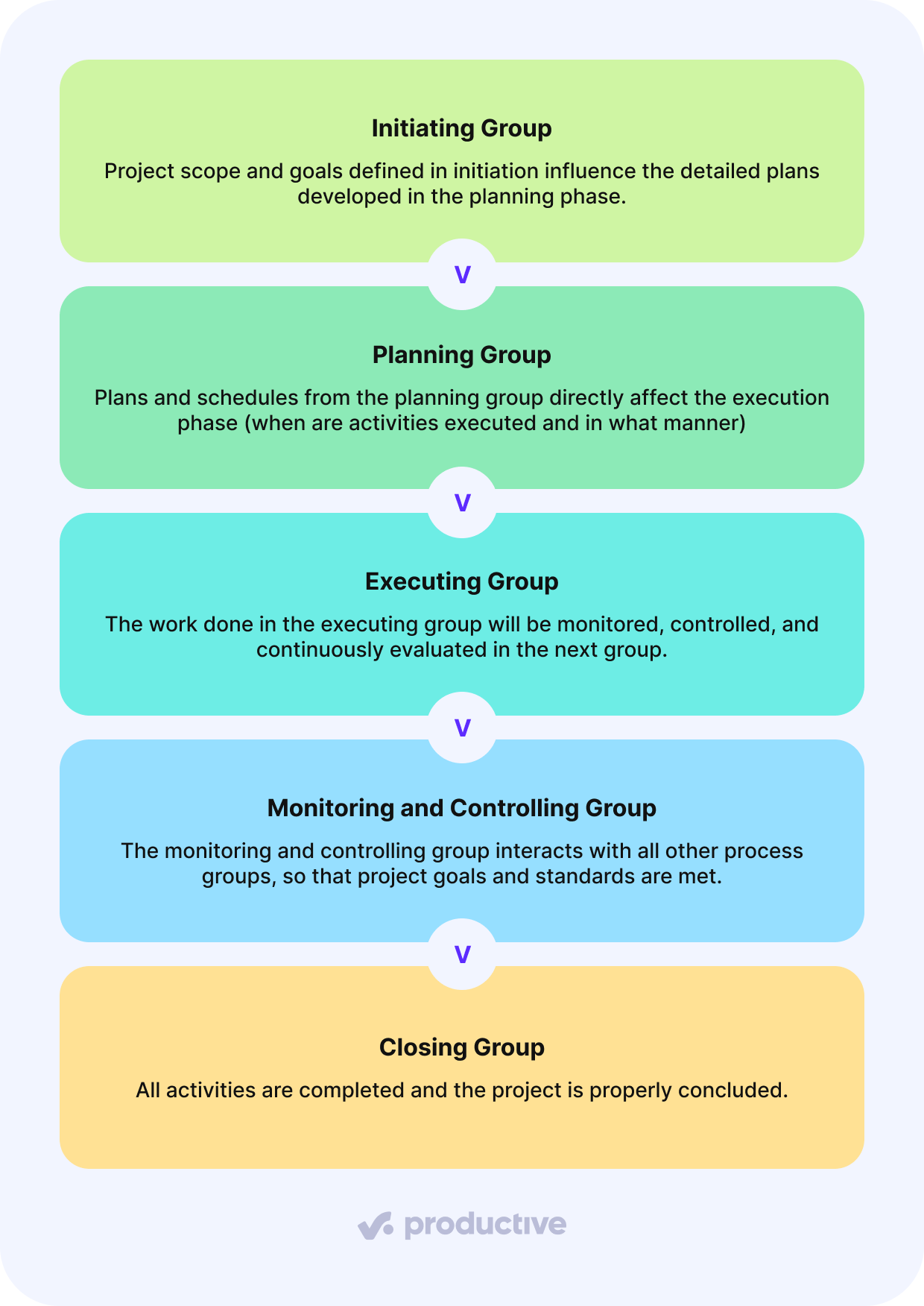
Project Lifecycle Impact
Understanding the impact of the project lifecycle is essential for effective project management. The structured approach of the lifecycle phases facilitates coordination, prioritization, and progress tracking.
It enables risk mitigation, adaptability, and performance monitoring throughout the project’s duration.
Clear objectives, efficient execution, and continuous client engagement guarantee project success and stakeholder satisfaction. This reinforces stakeholder alignment throughout the project lifecycle, which also supports ideal resource management and thorough project closure.
Here’s a breakdown of the factors ensure smooth workflows, effective decision-making, and well-managed resources.
- Coordination & Momentum: Keeps tasks and teams stay aligned throughout the project lifecycle
- Risk Management & Adaptability: Helps identify and mitigate potential risks while adjusting strategies as needed
- Success & Satisfaction: Ensures both team and client expectations are met with well-executed projects
Here are the essential project management guidelines that will contribute your project’s operational efficiency:
- Set Clear Objectives: Proper team coordination and risk mitigation strategies will always enhance project direction
- Prioritize: Track progress and monitor performance, this helps maintain focus on key tasks
- Task Sequencing: Organize workflows into focused stages, as it’s going to make issue identification and problem-solving easier and straightforward
- Documentation & Decision-Making: Record project insights so that your can teams make informed decisions and apply lessons learned
- Resource Management & Execution: first define, then aim for the optimal use of resources and efficient project closure
- Implement Project Management Software: Tools make can a huge difference and projects from chaotic to done. Project management software can automate your workflows and give you reliable real-time data with a project management software solution
Keep projects on track with Productive’s project management tools
Closing Thoughts on Project Management Progress Groups
You’ve learned about the five project management process groups from the Project Management Institute and how they’re connected. These groups form a continuous cycle throughout the project, with outputs from one group becoming inputs for the next one.
Recognizing how these process groups interact and understanding their distinct roles within each project phase will help you effectively plan, execute, monitor, control, and close projects. Every project manager needs to master these concepts.
Project management is easier and smoother with Productive – the all-in-one solution for handling projects of any size. Book a demo and see what Productive can do for you.
Connect With Agency Peers
Access agency-related Slack channels, exchange business insights, and join in on members-only live sessions.

